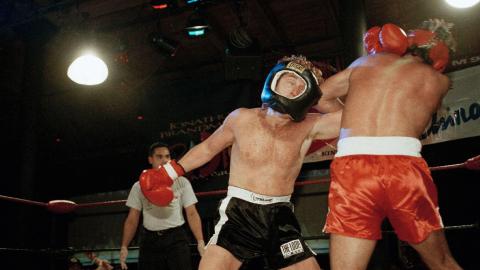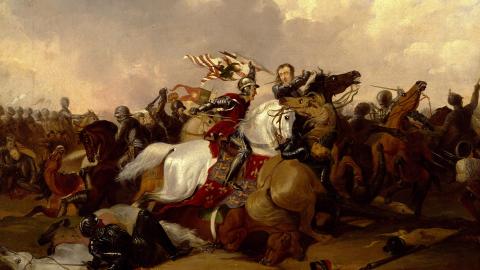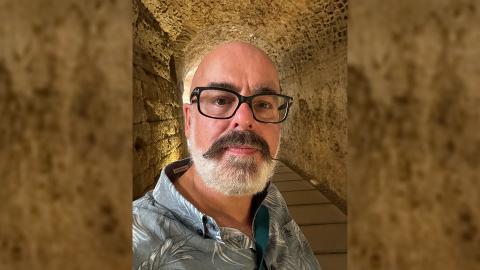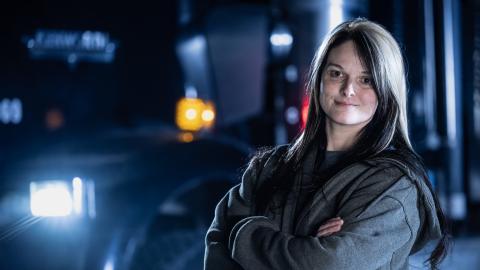Top 10 Tips for photographing historic places
Matt Emmett was crowned 2017 Historic Photographer of the Year for his stunning image of RAF Nocton Hall and US Military Hospital in Lincolnshire and we asked him to put together his Top 10 Tips for photographing historic places. You can follow Matt on Twitter, Facebook and Instagram.
Introduction
Photographing historic buildings and locations with amazing stories to tell is a huge amount of fun. When you create and publish an image, you have the opportunity to tell a part of the history of that place to a wider audience. This is vital to increase awareness of our historic environment and helps to educate and foster an appreciation of history throughout society.
Tip 1 | Enjoy What You Photograph
It may seem obvious but if you enjoy what you’re doing then you’ll do a better job. If you are interested in ancient ruins or military sites or churches or castles then it’s likely you will create stronger imagery there. That’s not to say you shouldn’t photograph anything else, but enjoyment and familiarity with a location will help you in the way you approach your subject.
This includes spotting details missed on previous visits or by talking to visitors or volunteers about the site and it’s stories. Photograph a historical site you enjoy and are interested in and you’re halfway to a good shot!
This image is of Box Freestone Quarry, a subterranean stone quarry in Wiltshire, UK. I’d seen this chamber in photos and exploring the vast network of tunnels was fascinating and exciting. Getting to put myself in the photo felt like the completion of a pilgrimage and gives the chamber a fantastic sense of scale.
You can pre-order the official 2021 Historic Photographer of the Year calendar from Amazon https://t.co/u8ovpGLCOL which includes this incredible image of the West Pier Ruins @BTNPalacePier in #Brighton by Ben Nazarko. #photography #Piers #hpy2020 pic.twitter.com/wjPwIAH5Uq
— Historic Photographer of the Year (@hpotyawards) July 29, 2020
Tip 2 | Know Your Equipment
It doesn’t matter if you are using a smartphone, tablet, point and shoot, mirrorless, DSLR or drone to create your images. Technology has advanced to such an extent that all are capable of creating high quality images.
Beyond image detail it’s the aesthetic choices made by the photographer that have the biggest impact. Most camera technologies set to fully automatic mode create an image where the exposure length is changed to average out the light entering the lens and create a pleasing and bright end result. Knowing how to take your camera off auto mode and take full control over the shutter speed, aperture and ISO will enable you to create a specific look.
Maybe you want moody with dark shadows or you want to blur a busy background using a wide open aperture and depth of field effect to increase attention on the foreground? Understanding your gear and how it works will really help you make deliberate choices that will dramatically improve the images you create.
This image of a narrow alleyway between workshops and storage areas was taken using a super-wide angle (10mm). Knowing the zoom-like effect that the lens would have on the walls at the sides of the image, I made the choice to point the camera upwards and not to correct the verticals in post-production, giving it a very dynamic feel.

Tip 3 | Take Lots of Photographs
There are very few photographers who can turn up at a location and create keeper after keeper with each shot. Take lots of photographs from various viewpoints and then curate the best images when you get home. Reviewing your photos to see what worked and what didn’t and then returning to the location to reshoot often also yields improvements.
The more you shoot the better the chance you’ll have a competition winner in the results!
This composite image of a tower folly in Berkshire was created at the time comet Neowise was bright in the skies over the UK. The folly marks one of the closest heritage locations to where I live and as a result I have photographed it lots of times. From the hundreds of photos I have taken here there’s only a handful I’m happy to publish.
Tip 4 | Do Your Research
Without context, an image of an amphitheatre or Cold War bunker is just an image of ancient stonework or gloomy tunnels. Researching the location prior to your visit can make your time there a lot more enjoyable and it can also help you when you shoot.
Including earthworks in the foreground of an image depicting the ruins of a medieval keep expands on its story, but you would have to know that the mound was significant to the location and not just part of the environment. It’s all about the research.
Scoping your location on Google Maps can help you work out the best angles and places to shoot from before you get there. Research will also help you caption your image because Historic Photographer of the Year is as interested in the story you have to tell of the location. As I said, it’s all about the research!
This is an image of a now demolished engine testing facility. It shows the view through an adjacent air intake pipe and into the open mouth of the testing environment. This image was one of hundreds taken over eleven separate visits to the site and after a lot of fascinating research.
Tip 5 | Consider Lesser-Known Locations
Travelling to an internationally-recognised site and photographing the main attraction from an angle that everyone else has will provide a pleasing composition, that’s why that shot has been created so many times before, but it’s also a downside.
Finding angles that work but have not been over-shot will provide imagery that feels fresh and new. Another good approach is to discover fascinating historic places that are not in every guidebook and create your imagery there. Some of my favourite images have been created in places that few people have heard about and the photographic experience in these kinds of places is usually much more enjoyable as there won’t be lots of people walking around in your shots.
This image was shot looking out of what was once an obscure concrete radar station that’s now slowly sinking into the sand at Warden Point on the Isle of Sheppey. There are three of these bunkers that used to sit on the cliff top back in the 1950’s, but over the years coastal erosion has brought them down onto the beach. This image employed a 10 stop ND filter to slow down the light entering the camera and has allowed a 50-second long daylight exposure giving the effect of smoothing out the waves.
Tip 6 | Think About Composition
Turning up and shooting a few images of your subject from wherever you happen to be standing can produce results, but it’s more likely you will find your optimum position if you keep on searching for the perfect composition. Move around the space and keep framing the view with your view finder and change the focal length of the lens you are using to see how that affects the results.
It’s also worth looking for compositions that most people wouldn’t consider, for example POV positions that show a well-known location in a new light or from an unusual angle.
This shot was taken in a stone culvert below an old ironworks in Somerset. Looking down into a fern-filled pit from above where a waterwheel was once sited gave me the idea of a shot that could be created if the camera was placed down in the tunnel looking out. Searching for and finding a way down into the tunnel proved to be well worth the effort!

Tip 7 | Consider the Light
This obviously requires having access to a location that doesn’t have specified opening hours but if you can be at your subject as the sun rises or during the wonderful light just before sunset then you may just be rewarded with a light show to enhance your photos.
Most people know what things look like during the daylight hours but show them something familiar in a new light or after dark using lights and you can create an amazing impact.
This shot was created at the Avebury Stones heritage site in Wiltshire, run by the National Trust. I arrived late at night and used a tripod and portable lights to illuminate individual standing stones from angles that bring out the texture and character of the megaliths. I hope you’ll agree it produced an intimate and unusual result.
Tip 8 | Tell Stories, Ask Questions
Creating an image with elements that make the viewer think or want to ask questions and know more is a powerful way to make it stay in the memory. This can be useful when the judges are considering a selection of images for inclusion in the shortlist. An image that is well composed and exposed may well be trumped by a similarly well taken photo that also has some meaning or story imbued into it, making it more memorable.
This image is the storage area for patient treatment records in a long closed psychiatric hospital in Italy. The paperwork spread across the floor has been left in-situ after the hospital closed decades before. The fact these documents remain here begs the question ‘why?’ and documentation regarding the previous patients scattered across the floor creates a poignant and striking image.
Tip 9 | Use a Tripod
Putting your camera on a tripod when shooting landscapes or architectural subjects can be a real eureka moment. Firstly with the tripod on solid ground and locked off so that camera doesn’t move, it means you can achieve better results.
Unless you’re shooting at very fast shutter speeds, even small amounts of jogging can be introduced when shooting hand-held. With a tripod this is greatly reduced and the images will be noticeably sharper.
Secondly, and perhaps more importantly, when you take the camera out of your hands and use a tripod you are forced to slow down, giving yourself more time to think about the image you see on the live view screen or in the view finder. It’s too easy to click away when you are holding the camera without thinking too much about each shot. Carrying a tripod with you on shoots is extra weight but it will pay dividends in the long run.
This image was taken inside a historic Thames Water-owned water storage cistern below Finsbury Park in north London. The camera was set to bulb mode and placed on a tripod for a 16-minute exposure whilst a side-facing light source was walked along the length of the totally dark space from either adjacent brick lane, resulting in a fully lit scene for the end result.
Tip 10 | Sensitive Post Processing
Becoming familiar with digital imaging software and techniques can be a wonderful way to enhance your results but can also easily be overdone too.
Images straight out of the camera can sometimes look a bit flat or dull from how you remembered the scene. Using software to bring the scene back to life is a bit of a balancing act, move the saturation slider too far and the colours can make the image feel cartoon-like. Less is definitely more when post processing. The options given by the software can also help you create images that would have been impossible in a single shot, like shooting different exposures of the same scene (brackets) and then creating a blended final shot (composite).
Stitched panoramic images are another good example of how software can help you create an end result that your kit simply could not capture without the extra help.
This is the view straight up through ‘The Octagon’ to the roof lantern at the majestic Victorian-era Crossness Pumping Station. The majority of digital cameras produce a rectangular image, however the format of this image is symmetrical and square. In constructing this image I used a super-wide angle lens looking straight up from a central point below. One shot was created to align with the decorative panels above and then I rotated the camera 90° to create an overlapping shot. More images then captured the four missing corners to the intersecting cross shape created by the previous two shots. Once back at the computer I joined the six images together using alignment and digital blending techniques to create the finished composite.
Without use of the digital techniques the only other way to create this image would have been to use a fisheye lens, but that would have turned the straight lines above into curves.
For more information head to Historic Photographer of the Year.













